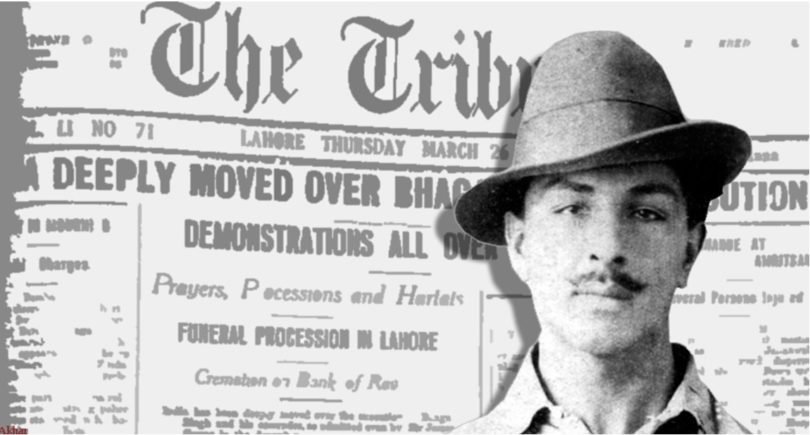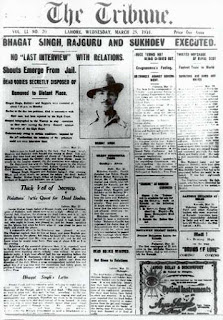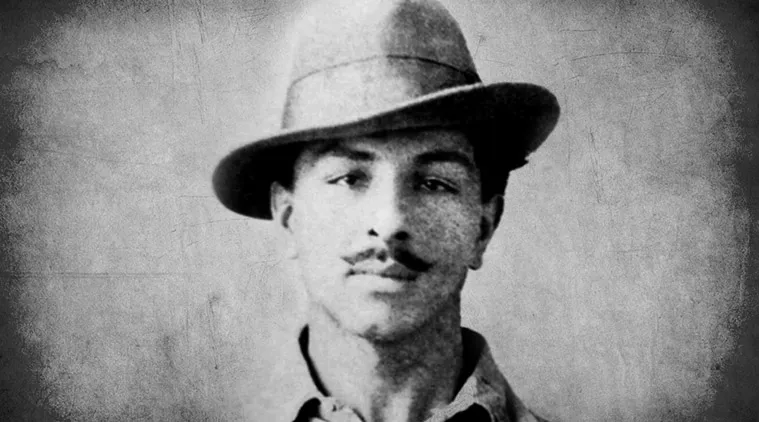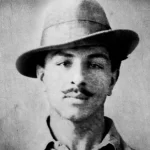Tribute to Bhagat Singh by Sergio Bhairo
Today on the anniversary of his birth I pause to reflect on the ideas and life contribution of someone who died eighty-six years ago. Bhagat Singh was a mere 24 years old when he died. He however, left a lasting impression on millions of people In India.
Seldom in a country’s history has someone so young had a profound influence on a country’s history. He was a revolutionary martyr who propelled India’s fight for Independence from its colonial master Britain by giving his life.
Born in an area of colonial India that is now in the state of Pakistan Bhagat Singh decided at the early age of 13 to leave the colonial school system and go directly into a life of active fighting for India’s independence. It is amazing to think how mature and proactive he was even before he fully became what we would call a teenager.
 Much of his life history has been distorted and exaggerated by the British colonial historians. They portrayed him as a violent, criminal thug. What he did was to get involved in demonstrations against the ruling masters. He felt that active rebellion in the context of his times was appropriate action. The authorities quickly saw that his vibrational energy and activism was a serious threat to their ruling system. He was arrested on several occasions.
Much of his life history has been distorted and exaggerated by the British colonial historians. They portrayed him as a violent, criminal thug. What he did was to get involved in demonstrations against the ruling masters. He felt that active rebellion in the context of his times was appropriate action. The authorities quickly saw that his vibrational energy and activism was a serious threat to their ruling system. He was arrested on several occasions.
Eventually, after a show trial, Singh was found guilty of killing a British officer. He was convicted and hanged on March 23 ,1931. This 24-year-old never lived to see the Independence of the country for whom he gave his life.
Bhagat was born into a revolutionary Sikh family in Punjab. His family were dedicated nationalists. When he was born his father was in jail for political activities against the Colonial master state.
At the early age of 13 Bhagat was well aware of his family’s revolutionary views and actions. His father supported Mahatma Gandhi. Following Gandhi’s call to boycott British aided institutions he left school and became a student of the Lahore National College. He plunged into studying European Revolutionary movements.
As a result, he became disenchanted with Gandhi’s nonviolent approach to confronting the British. He was convinced that armed conflict was the best way to drive the British out and claim India’s nationhood.
 Eventually, a further police investigation found the link between Singh and the Officer Saunders murder. He was charged. While waiting for this trial he masterminded a prison hunger strike.
Eventually, a further police investigation found the link between Singh and the Officer Saunders murder. He was charged. While waiting for this trial he masterminded a prison hunger strike.
Singh and his fellow conspirators were finally tried and convicted. He was executed by hanging on March 23,1931. Singh’s short life had a significant impact on India’s fight for freedom. Some followers of Gandhi thought he was too socialistic and violent. Others felt that he was a martyr and had raised the consciousness of many, particularly young people to take firm, determined action against the national oppressors.
The vibrational power of Singh’s actions and words reach out today across the world. Some who believe in his dream for a more balanced society have created schools which place an emphasis on critical thinking and character development.
I am one of those with a dream to establish a school based on his ideas in Bay Point in California. I want to enshrine his values of human dignity and equality in the young so that they can create a truly democratic society.
Many still do not realize that Singh grew from early basic violent revolutionary activity and transcended that to eventually project a vision of an Indian nation that was secular, socialist and egalitarian.
It is astonishing that such a young man was able to look beyond just the gaining of freedom. He had the vision to establish a classless society. India, he felt, should be a society in which everyone (not just a privileged few) would have equal opportunity.
Writing from prison on March 3rd, 1931 he was quite explicit saying, “The struggle in India would continue so long as a handful of exploiters go on exploiting the labour of the common people for their own ends. It matters little whether these exploiters are purely British capitalists, or British and Indians in alliance, or even purely Indian”.
Indian society is still trying to make sense and grapple with the issues of caste and religious discrimination. Bhagat Singh had definitive views on both casteism and communalism in the 1920s.
In his writings and court statements, he mocked the political leadership for its hypocrisy in dealing with these crucial issues, expressing surprise that we are still debating who should be allowed into a temple and who should have access to the Vedas.
“A dog can sit in our lap”, he wrote, “can walk around freely in our kitchen while mere touch of a human being will lead to a religious outrage” ” we worship animals but can’t sit with human beings”.
He was equally blunt on the issue of communalism and saw communal amity as an important part of his political programme.
Bhagat Singh questioned the policy of encouraging competing communalism, which ultimately led to the partition of the country in 1947. He thus stands out in bold relief as a modern national leader and thinker, emphasizing the separation of religion from politics and state as true secularism.
The Indian nation after so many decades of existence still has major socio-political and economic disparities. Bhagat Singh’s vision of social and political justice continues to be relevant and his ideals should inspire us to take the struggle forward.
Sergio Bhairo -President of CSAHC





